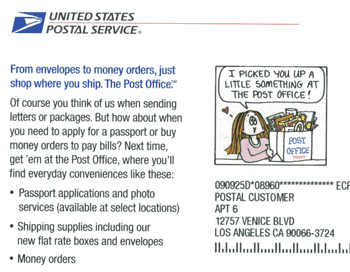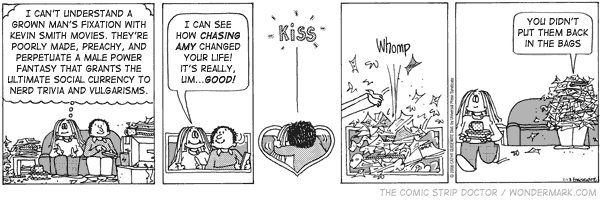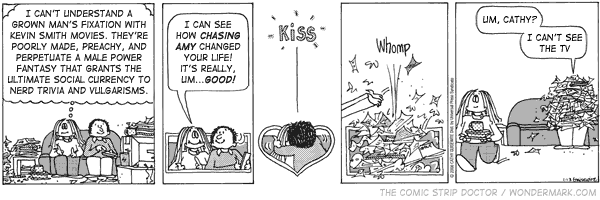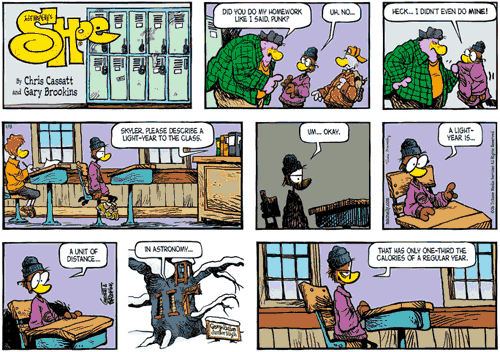
Blog
The Comic Strip Doctor: Cathy

(Click any of the smaller images to zoom in on them.)
A Universal Press Syndicate interview with cartoonist Cathy Guisewite calls Cathy “the first widely syndicated humor strip by a female cartoonist.” The transparent qualifiers “widely syndicated” and “humor” are not mere press-release puffery; they are, in fact, quite deliberate, for without those qualifiers, the statement is inaccurate.
A casual reader of the statement may come away with the impression that Cathy was the first syndicated comic strip by a female cartoonist. (In fact, that honor goes to Dale Messick, for Brenda Starr, beginning in 1940.) But being the first at something is a powerful branding tool, and with enough qualifiers, anyone can be the first at something.
Cathy is widely regarded as the first comic strip that spoke to a generation of working, struggling women in a voice that resonated as one of their own. In the mid-1970s, Guisewite was a successful advertising copywriter with typical insecurites about her love life, her relationship with food and her weight, and the hassles and stresses of work. She doodled little characters expressing her angst on letters to her mother, who pushed her to submit to syndicates. As she puts it:
Universal Press was really looking for a strip that addressed these [women’s] issues, and while they had had many submissions from men, they thought that my work had an emotional honesty that the men just couldn’t approach. […] I think I got a contract to do “Cathy” faster than anyone has ever gotten one in history.
When the strip first appeared in 1976, women’s rights were being newly asserted both in the workplace and in the arena of relationships. The character of Cathy was a young, single, independent woman with the same fears, uncertainties, and challenges as an entire generation. Guisewite again:
I get way more feedback from people who say that they love Cathy because she’s not afraid to admit that she doesn’t have it all together every day […] they say it’s refreshing to read Cathy and know that there’s somebody else out there who’s still hauling around a 40-pound purse full of dreams.
Bathing suit doesn’t fit? Cathy’s got your back. Mom driving you nuts? Cathy’s been there too. Men just don’t understand you? Oh, Cathy — it’s you and me against the world.
And so every petty dilemma in a woman’s life, every mundane struggle and boilerplate annoyance, suddenly became an “AACK!”-worthy crisis.
Since 1976, the role of women in society has changed dramatically. An entire new generation has arisen that doesn’t give a second thought to working for a living, for example, or more broadly, taking responsibility for one’s own happiness and fulfillment. The average marriage age is older than ever before, as young people — and young women, in particular — are realizing that they don’t need to define themselves in terms of their role in a relationship. Women of today’s generation are every bit as comfortable with technology as men. And yet Cathy AACKs her way through her job, her relationships, and her shopping obsession, puzzling over Irving’s “male brain” and turning every visit to the mall into a sweat-soaked, cookie-fueled, nuclear-grade emergency.
The central relationship in Cathy’s life is her love/hate affair with consumption. Like many women, Cathy suffers from a poor body image, and struggles to conform to society’s unreal image of ideal femininity. She wages seasonal battles with the latest trends in swimwear, formal dress, and shoe fashions; she also fights herself internally, rarely motivating herself to exercise but often guiltily binging on snacks. Her endemic weakness for food, apparel, and tchotchkes makes her unremarkable at best and pathetic at worst.
And yet this sad figure is held up as a beacon of commiserative hope for women? Cathy’s weaknesses reinforce whatever stereotypes they are intended to bolster sympathy against. By saying to women, “Don’t worry, I feel bad about my weight too,” Cathy is saying, “Feeling bad about your weight is something that women do,” and excluding positive, healthy thoughts from the realm of “what women do.” By saying, “Ha ha, sometimes I buy too much stuff, just like you do,” she is saying, “Shopping compulsively is a trait of women in general,” and excluding those who exercise self-control as not real women, or at least not “normal” women. Because Cathy is a “normal” woman, and to be a “normal woman” in Cathy’s world, you have to obsess about your thighs, hate your mother, carry around a precious little dog and marry a doofus.
The aforementioned doofus, Cathy’s husband Irving, is a shallow foil for Cathy’s various neuroses. Like the ever-present Saleswoman, more about whom below, Irving exists mainly so that Cathy‘s readers can sigh knowingly, say “Oh, men!”, and put the comic on the fridge for their longsuffering husband to read. Irving likes golf, gadgets, and against all odds, Cathy herself, despite the fact that she is a shrill, bitter harpy. Her one redeeming personality trait is her silence on how abjectly dull her husband is.
Irving was Cathy’s long-term boyfriend for many years, until Guisewite decided to reintroduce Cathy to the dating world; then, after a string of cardboard beaus, she decided to marry Cathy off to expose a rich new vein of comedic material. Re-enter the longsuffering Irving, the “nice guy” with no identifiable personality beyond his general “maleness” — in other words, an aversion to housework, an impatience with shopping, and an affinity for gadgets:
Irving, and in fact the entire male species in Cathy‘s universe, exists merely to frustrate women. And any currency that Guisewite might earn for her portrayal of Modern Woman as a complex, nuanced creature with desires and hopes and fears underrepresented by mainstream media is spent by her repeated, “good-natured” slogs through Stereotypeville, U.S.A.:
The Saleswoman character is Cathy’s nemesis. Never named, never personified except by her attempts to batter Cathy’s willpower, she typically tries to push a product on Cathy that Cathy doesn’t need. Cathy’s resistance is therefore an act of heroism against the Establishment:
But any sign that this self-control is a redeeming character trait on Cathy’s part, or that it’s part of Guisewite’s campaign to empower or encourage the Modern Woman against the tantalizing forces of consumerism, is obliterated as soon as Cathy reverts to Stereotype Mode:
The preceding two comics were published three days apart, and yet they are diametrically opposed in terms of worldview. Can Cathy have it both ways? Is she the modern, Empowered Woman, or is she the giddy girl who can’t pass up a shopping bargain? Guisewite appears to remain on the fence about which female stereotypes she wants to indignantly shatter and which she wants to giddily indulge in. Equal pay for equal work, but can’t we gals still go shopping? Can we diet away from our cake, but still eat it too?
Guisewite may be exploring this contradiction by painting her character as conflicted, but a more likely explanation is that the entire “shopping” construct is merely an artifice for a series of lame gags, and that there is no character development happening whatsoever.
Logically consistent within that premise is our earlier assertion that Cathy‘s main import has been to elevate the mundane, typical bothers of daily existence into a sort of pseudo-operatic cacophany of global prosecution, in which every personal tic and foible has the booming quality of an Aristotelian tragic flaw, and every interaction with one’s husband, mother, boss, or dog is a clash of titans. Department store dressing rooms become gauntlets of terrible trials, and bikinis must be tried on with one hand while the other defends oneself from the fierce, flaming arrows of The Entire World Against You, your plaintive, bellowing “AACK” reverberating forever in the Halls of Eternity.
You see, everyone alive today has problems. Of every sort. Some of us figure out how to get past them and not let them take over our lives. For the rest of the world, I suppose, there’s always Cathy.
I am going to break form here and abstain from my usual habit of re-writing a specific comic strip. I have no interest in making Cathy funny. *(See “Update,” below.) I will, however, comment on a rather peculiar thing I found in my mailbox recently: it seems that Cathy has teamed up with the U. S. Postal Service, as a way of educating postal customers about the many services available at your local post office.
There are four, or maybe six, different postcards, featuring postal-themed Cathy strips on the reverse; I’ll spare you the full brunt and merely show the strip on the reverse of the above mailing:

Seriously, a money order?
Despite the obviously sociopathic tendencies of this strip’s protagonist (typified by an unhealthy fixation on low-grade, overpriced packing supplies) it is recognizably the same character from the non-commercially-licensed version of the comic; she has the same frenzied compulsion to buy everything in sight. (Modern Woman, take heed.)
In the past, Cathy’s shilled for Betty Crocker and the wedding website thebigday.com (the latter in the form of product placement within the newspaper strip itself); she’s also spoken for (oddly enough) Glamour magazine and McDonald’s. I don’t recall the McDonald’s ads personally, but I imagine they were something along the lines of, “McDonald’s food is so healthy, even weight-conscious Cathy is happy to indulge herself. Go on, insecure women of America; stuff your freaking face.” I’m sad to report that the message seems to have worked.
Divorced by time and progress from whatever socially progressive message it may once have had, Cathy lives on as a cutesy, tape-it-to-your-cubicle strip that gives voice to the myriad ever-present annoyances that seem so very important but are really no more than the normal bumps on the road of every day. By doing so, it has encouraged a culture that treats every slight as a mortal wound and every bother as a tragedy; it echoes (or is echoed by) the petulant cry of a nation that can’t develop, say, a healthy resistance to advertising, or a stable relationship with another human being based on compromise and understanding. What was once a novel voice of understanding to a generation finding its way is now a shrill whine that grates on the ears of a new generation.
Do you smell that, Cathy? It’s the winds of change …
Oh, wait. You’ve got no freaking nose.
UPDATE: I have been taken to task for shirking my Hippocratic oath and refusing to treat this patient. Thus, the following.
My initial opinion of the above comic was that it made no freaking sense. My second consecutive use of the adjective “freaking” in as many column inches is testament to the fact that I have no idea what is happening in this comic.
Originally published on January 13, 2006, this strip finds Cathy and Irving sharing a tender moment on the couch. At this point they’ve been married for eleven months. Irving is utterly content to wallow in filth, watching TV. At first I thought he was playing video games, because both of his hands are engaged, but the second panel punches in to reveal a remote control (or Wiimote) in his hand.
Every remote control that I’ve ever used was designed to be operated one-handedly. That is the basic principle of the remote control. Yet Irving cradles the remote in his left hand and jabs at it with his finger. He’s leaning forward in his chair, a wide, earnest grin on his face; if this strip were my first introduction to the character, I’d have him pegged as a ‘tardder.
Meanwhile, Cathy’s a nervous wreck, perched with her hands twitching on her knees, looking at everything that has to be done — sorting through papers, cleaning up after the dog, “re-doing” that “whole bookshelf.” Generic particles of unidentified nast float through the air and come to rest on every surface.
In the second panel, Cathy turns to Irving. We know what she’s thinking; we read her whole novel about it in the previous panel. His head whips around, his giddy enthusiasm unconcerned with which activity it’s focused on. He’s clearly been waiting for any excuse to pounce amorously on Cathy — perhaps his viewing choices have “primed his pump,” so to speak. Maybe that’s why Cathy anxiously seeks out something — anything — else to focus her attention on.
I can see the conversation from earlier that evening progressing somewhat like this:
Irving: “C’mon, honey, it’ll be fun, it’ll get us into the mood…”
Cathy: “AACK! AACK! MOTHER NEVER WARNED ME ABOUT THIS!”
Irving (sighing): “Okay, well, I’m gonna put in the DVD — just give it a chance, okay? It’s really not –”
Cathy: “MEN! THEY’RE SO GROSS! AM I RIGHT LADIES?”
By panel three, Irving’s finally gotten the chance he’s been waiting for — he’s been spring-loaded for an hour now, just waiting for the barest sign that Cathy’s finally come around, or is willing to at least play along to keep the peace. At this point, he doesn’t need cooperation — all he needs is acquiescence. He seizes the opening.
Panel four neatly sums up Cathy’s relationship with the world. The perfectly reasonable idea that a husband may occasionally be forward with his lawfully wedded wife is trumped in favor of Cathy’s crippling obsession with life’s minutiae. Are receipts really that important, Cathy? So important that not only would you choose it over a romantic evening with your prefab, cardboard husband, but you’d in fact be bitter should he not see things the same way?
We’ve already established Cathy’s love affair with consumption. Now a new facet emerges: that it may in fact supplant any real relationships in her life. She is clearly uninterested in giving herself wholly to the man with whom she shares a house — not emotionally, not experientially, and not, as we can see from this strip, physically.
Upon first reading of this strip, I didn’t really understand the last panel. How could she be more excited by the prospect of vacuuming up dog hair from the carpet than by spontaneous romance? This speaks to a personality disorder so severe that I couldn’t bring myself to believe that I wasn’t reading the strip wrong and missing some obvious punchline.
But now, after puzzling out this whole disturbing backstory that implies a crippling (and thoroughly unsurprising) frigidity on Cathy’s part, I can’t conceive of any other explanation. Cathy is a broken person. And what’s worse is that according to that smug smile in the last panel, she’s happy about it.
I cannot overemphasize this final point enough. She doesn’t see anything wrong with the way she feels. As we’ve established, freaking out over every petty annoyance is considered “normal” for Cathy (and, by extension, for Modern Woman, according to Guisewite’s twisted logic). But now we see that the freakouts are part of a larger defense mechanism — by obsessing over receipts, she never has to deal with the more pressing question of intimacy. By doting on her dog, she never has to enter into a mature, adult relationship with her husband. By making a full in-basket at work into a life-threatening event, she never has to examine her life goals in a broader sense, never has to re-evaluate whether her career is leading her down a path she’s sure she wants to tread. She fills her days and her nights with distractions, because it’s easier that way.
The empowerment that Guisewite has devised for Modern Woman has become her prison. She spent so much time fighting to get into the workplace that she never stopped to think about whether it was what she really wanted. I don’t mean to appear critical of women’s rights in general; I think women should have every avenue open to them. But in Cathy’s case, every aspect of her life — from her job to her marriage to her purchases — feels prescribed; like she’s going through the motions of the life she feels she should want, and filling up her days with mindless busy-work because she’s scared to face the bigger questions.
When Cathy is on her deathbed, the things she will regret will be unrelated to the size of swimsuits.
Perhaps it’s a latent patriarchical fear of speaking out of turn, or a simple reluctance to admit that the doors opened by “empowerment” lead to hallways into which the light does not penetrate. In any case, Cathy’s shrill superficiality is a mask that hides a scared child, terrified of real risk or change or of exposing any sliver of vulnerability. Irving likely does not necessarily realize this; he doesn’t seem like a white-knight type, hoping to fix her with his broad, strong shoulders. He seems instead like a decent dude, who’ll absorb the high-volume abuse tight-lipped for days and weeks and years, and at midnight on their twentieth anniversary it’ll take every ounce of resolve in his body to not reach slowly over and snap her neck in her sleep.
Here’s my first suggested revision for this strip:
The assumption here, based on the Kevin Smith reference, is that what Cathy dumps on Irving is his comic book collection. However, this assumes a baseline familiarity with comic collecting on the part of the reader. Part of the difficulty faced by Guisewite and other mass-market cartoonists is the urge to make every single strip as broad and accessible as possible. In this case, I’ve stepped too far in the other direction.
One of the many advantages that I enjoy relative to cartoonists like Guisewite is the ability to revise the work. Once the strip’s in a newspaper, that’s it; it’s done. Guisewite has to hit her deadline, and whatever state the comic’s in when that bell tolls, that’s what runs in the paper. But online, there is no such finality, and no need to abandon work that can still be improved. Here’s my final version.
Until next time… I’ll see you in the funny papers.
— January, 2007
What are scraps of crap?
Scraps of crap are all the things we have the most fun creating. The idea with a scrap of crap is to capture the sketchy energy of drawing (or creating anything) without the pressure to turn it into a masterpiece.
How many times have you sat down to draw (or write, or compose, or do anything) with all your tools neatly lined up in a row, and the light adjusted just so, and everything just “perfect” in every respect — and then you stared at the paper and nothing came out?
I call this the “tyranny of the blank paper,” in honor of my first art mentor, John Arthur Williams. John used to sit with us in his studio with a ream of blank paper in his lap, and while he talked, he’d systematically crumple a brand-new sheet into a ball and throw it into the corner of the room. Over and over, crumple, throw, crumple, throw, as we watched in disbelief.
“You’re wasting paper,” one of us said; it could have been me, but I’m not sure. John shrugged and crumpled another ball. “Paper’s cheap,” he said. “You shouldn’t be afraid to waste it.”
The lesson was that artists shouldn’t feel like everything they make has to be a museum-quality masterpiece. Playing with technique, working out a composition, or just sketching with no aim in mind is an integral part of the creative process. It helps your mind feel out its strengths and weaknesses. It’s hitting the gym for your creative spirit.
With that in mind, the scraps of crap on this site are a collection of just that — crap that you’d never hang on a wall, but which nonetheless contains a spark of fun, of energy, even of grace that’s sometimes hard to find in more “finished” work. After all, when you’re doodling on an envelope, there’s no reason not to play around as much as you like — you were gonna throw the envelope away anyway.
With that in mind, I’ll be posting doodles and sketches of mine, both current and from the past, as well as those from various contributors. I hope you enjoy them!
Child’s Play Print Auctions

The three Child’s Play auctions were a tremendous success. Here is a recap narrative to take you through all the WILD TWISTS AND TURNS.

The first image was a placid landscape scene! Take a closer look here.

The winner was the friendly and gregarious Thomas, who bid $242.73. Thomas happened to be in my area and kindly offered to pick up the print in person:

The second print was a ponderous meditation on the nature of consciousness. Take a closer look here.


The winner of this piece was Jason, who bid $247.50. I packed Jason’s print in a large box:

The third print was a careful reconstruction of a moment of elation we all felt at some point in about the second grade.

Take a closer look here.

The winner of this one was Adam, who bid $252.97. I packed Adam’s print in a box similar to Jason’s. Because I anticipated that the post office would not be, shall we say, thrilled at the prospect of manhandling these two large, fragile boxes around their destructi-facility, I attempted to ease their burden with levity:
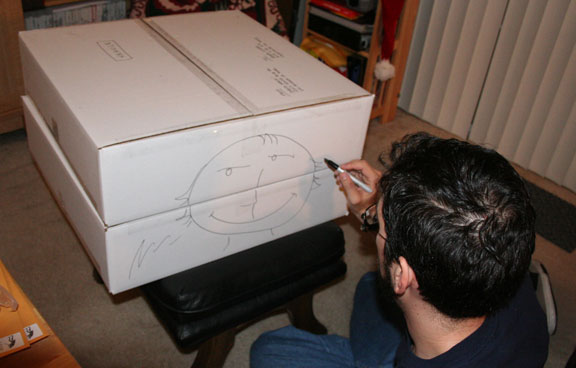
I wanted to be more elaborate, perhaps something approaching a fresco, but time was at a premium. So I rushed to the post office and arrived mere seconds after they closed, the employee swinging her key-lanyard around on the other side of the doors as if to say, “Screw every one of you suckers racing towards me from the parking lot with murderous gleams in your holiday-shopping-crazed eyes.”
Anyway I went back another day and everything is peachy now.
The total amount bid from all three auctions combined is $743.20. I am absorbing all the eBay and PayPal fees, because that’s what Gabe and Tycho do — Child’s Play doesn’t take any administrative fees, and all of the donations they receive go directly towards the cause; namely, helping to make the time that sick kids spend in the hospital a little more enjoyable. I’m happy to have done my part.
Kid, don’t throw your Wii controller through a window or something.

Thanks for bidding, everyone, and I hope you enjoy the prints!
Update: Jason sent a picture of the safe arrival and display of his print!

Hooray!
The Comic Strip Doctor: Shoe

(Click any of the images to zoom in on them.)
Shoe was in my hometown newspaper growing up, and I read it every day, just like I read Fred Basset and Herb & Jamaal and Marvin, and I don’t think I ever laughed at any of them, ever. But I did look forward to reading Shoe, especially on Sundays, because the fledgling artist in me was drawn to Jeff MacNelly’s expressive brushwork — I wanted a DeSoto like Cosmo’s, with tailfins jutting skyward; I loved the collection of jagged lines that created, with negative space, a towering stack of papers on the Perfesser’s desk. So it is with a shade of reluctance that I must admit that Shoe sucks.
Like most comics that’ve been around over a decade, Shoe is not drawn by the original creator. When Jeff MacNelly passed away in 2000, Chris Cassatt and Gary Brookins, both editorial cartoonists in their own right (like MacNelly himself), took over daily production of the strip, aided by MacNelly’s widow Susie and a pair of staff writers. Cassatt and Brookins have achieved a fine pastiche of MacNelly’s style; they draw very decent trees, and all the characters look like they’re supposed to. But perhaps due to their training and experience in editorial cartooning — a field in which brevity is livelihood — they struggle with using the newspaper gag strip format to its full potential, often stretching a simple, lame gag out over two wide panels (when a third panel, and accompanying second punchline, would be no chore to add):
And despite the wide canvas available to them on Sundays, Cassatt & Brookins choose to maintain the languorous pace:
The example above is strikingly typical in its slowness: in fact, every Sunday Shoe that I examined could easily be retold in a daily three-panel format without losing anything but unneeded fat. The characters speak in ellipses, breaking a single sentence into labored wheezing over the course of three or four panels; brief, few-word back-and-forth conversations inexplicably take the entire strip, with only one dialogue balloon per panel. The wasted space speaks of wasted potential — both for the existing jokes, which suffer from the meandering pace, and for the additional jokes that could easily fit into the same space, making the comic snappy and unexpected. Instead, we get the above, with shadowy panels, cutaways to exterior shots, and subtle changes in perspective trying desperately to fill time while the characters move in slow motion.
Like most Sunday comics, the above episode of Shoe features a two-panel throwaway gag in the first position. This is for the convenience of the editor at each particular newspaper: depending on space constraints, the editor may choose to run the comic as-is (title panel, two-panel gag, and main gag); or he may choose to clip the top three panels and run the main gag alone. Also, the careful grid-like arrangement of the panels is no accident — this is so the editor may rearrange the number of panels per row, again for reasons related to the space available on the page.
In fact, the preferred panel arrangement for the above comic is probably the following (a quick check on the official Shoe website tells me I am correct):
The difference is slight but significant. In this latter arrangement, the title and the two-panel gag are all on one line, and the main gag begins on a new line. This provides a beat of separation between the two, and it is easy for the reader to “complete” the first gag before starting to read the second. In the former arrangement, there is no such separation, and the entire arrangement reads like one long gag, making it that much more unsatisfying when the end is finally reached.
In other words: the two-panel gag, with the tough in the green threatening Skyler, is a single, standalone event, and Skyler’s answer “Heck…I didn’t even do mine!” is the punchline. The teacher asking Skyler to describe a light-year is the beginning of the main gag, which terminates five panels later. But when the panels are rearranged, Skyler’s “Heck” line doesn’t act as a punchline; instead, it’s a setup for the panels that follow it. Not only does it lower the total gags-per-comic quotient by half, it also means that Skyler’s “calories” punchline at the end of the whole ordeal is even lamer for having had seven panels of setup.
This is an argument for retaining the artist’s intended layout when reproducing comics. It’s an argument that Bill Watterson fought and won, largely by refusing to carve his comics into modular blocks that could be rearranged, knowing that editors would have no recourse — they wouldn’t dare cancel his wildly popular feature. Watterson’s victory has had a wicked backlash; many metropolitan newspapers today are subjected to the vulgar garishness of Berke Breathed’s Opus above the fold on the front page of the comics section, a prime position that Breathed won in the wake of Watterson’s trailblazing, and a position that he has used to curse the people of America with his bleatings.
But Opus will be the subject of another column, perhaps; in the meantime I think that the above Shoe will benefit from a greatly accelerated pace, or at least a more judicious use of the space given. To add many layers of density to the comic would be to violate the regular spirit of the strip, which is a problem I am unconcerned with:
Until next time… I’ll see you in the funny papers.
— December, 2006






